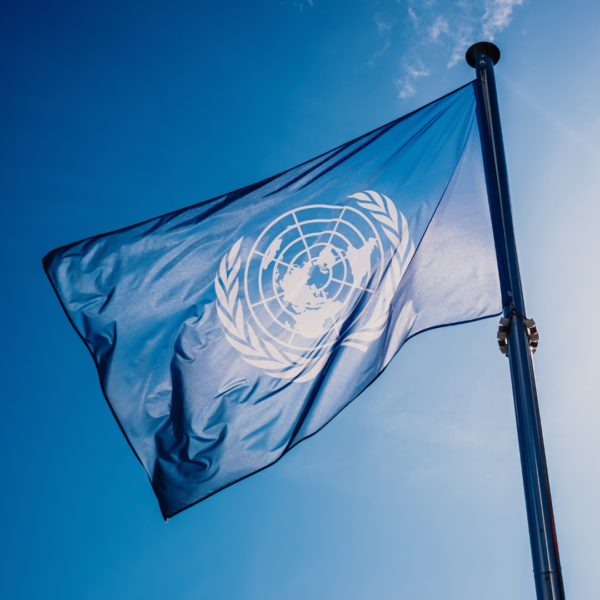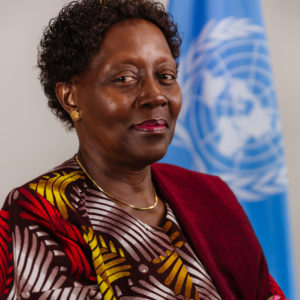Greening Rights : Progress, Reflections, and Future Horizons
Reading time : 5 minutesThe human right to a clean, healthy, and sustainable environment traces its roots back to the 1972 Stockholm Declaration which spurred the creation of the United Nations Environment Programme (UNEP). UNEP has since then worked tirelessly to translate this global consensus into policy. What has been achieved? What are UNEP's next steps? In this article, UNEP's Deputy Executive Director, Elizabeth Mrema sheds lights on these fundamental questions.

The human right to a clean, healthy, and sustainable environment traces its roots back to the 1972 Stockholm Declaration which spurred the creation of the United Nations Environment Programme (UNEP). The first principle of the declaration asserted that each person has “the fundamental right to freedom, equality, and adequate conditions of life, in an environment of a quality that permits a life of dignity and well-being.”
On July 28, 2022, the United Nations General Assembly adopted a historicresolution(known by its number, 76/300) that formally recognized the right to a clean, healthy, and sustainable environment as an independent and universal human right. This followed the adoption of a similarresolutionby the UN Human Rights Council in October 2021. These watershed resolutions were the culmination of decades of efforts, integrating the right into constitutions and national laws in over 160 countries, and regional agreements exemplifying the intertwined relationship between human rights and environmental protection.
The adoption of the Resolution 76/300 was a moment ofglobal consensuswith 161 states voting in favor, 8 abstaining, and none against. It was a powerful response to calls to action fromcivil society and Indigenous organizations,National Human Rights Institutions,business actors as well asUN entities.
Beyond the overwhelming support, this record represents recognition of the human rights challenges posed by the triple planetary crisis—climate change, nature loss, and pollution, and the need to address environmental challenges for both the planet and people in an integrated manner.
And, crucially, it embodies a human rights-based approach to environmental actions. This amplifies the voices of those most vulnerable to environmental impacts, including women, children, as well as Indigenous Peoples and local communities. It holds the promise of fostering transparency, enhancing accountability, and fighting environmental injustices.
The legacy of 76/300
Resolution 76/300 has ushered in transformative changes and impacts. These include :
- Greater legal recognition of the right at the national and regional levels.Canadahas recognized the right to a healthy environment through domestic legislation. In addition to 13 parties,BelizeandGrenadahave recently become Parties to the Regional Agreement on Access to Information, Public Participation and Justice in Environmental Matters in Latin America and the Caribbean (Escazú Agreement) where Articles 1 and 4 stipulate the right to a healthy environment.
- Advancements in Multilateral Environmental Agreements (MEAs). Notable examples include the climate changeSharm el-Sheikh Implementation Plan, the Convention on Biological Diversity’sKunming-Montreal Global Biodiversity Framework, and theBonn Declaration for the Sustainable Management of Chemicals and Waste, all setting the stage for a more comprehensive and interconnected approach to addressing global environmental challenges.
- Integration of the right to a healthy environment in human rights treaty bodies includingGeneral comment No. 26 on children’s rights and the environment with a special focus on climate change by the Committee on the Rights of the Child in May 2023, General comment No. 26 on Land and Economic, Social and Cultural Rights by the Committee on Economic, Social and Cultural Rights in December 2022, andGeneral recommendation No.39 on the rights of Indigenous women and Girlsby the Committee on the Elimination of Discrimination against Women in October 2022.
- Intergovernmental bodies have embraced the right to a healthy environment. The UN Human Rights Council has incorporated environmental issues, covering a spectrum fromclimateandtoxic substancestochildren’s environmental rights,the rule of law,environmental defenders, and business responsibilities. Likewise, the UN Environment Assembly has acknowledged GA Resolution 76/300 as well as Human Rights Council Resolution 48/13 in its Political Declarationof the special session of the United Nations Environment Assembly to commemorate the fiftieth anniversary of the establishment of UNEP.
The examples not only represent policy-level changes or commitments but also signal the establishment of viable pathways for the effective implementation of the right to a healthy environment.
Translating policy into action
Transforming the recognition of the right to a clean, healthy, and sustainable environment into a tangible reality necessitates coordinated efforts at all levels.
At the country-level, implementation involves accelerated coordination efforts between ministries and other government agencies. It’s also important for countries that have not yet recognized the right to incorporate it into their national legal systems.
Regional and international-level implementation is equally crucial, given that environmental harm knows no national borders. Regions should either strengthen existing regional environmental rights agreements or develop new ones. Environmental rights should also be integrated into reporting for international human rights monitoring and review processes, such as human rights treaty bodies’ reviews and the Universal Periodic Review of the Human Rights Council which calls for each UN Member State to undergo a regular peer review of its human rights record.
Implementation efforts should prioritize those most vulnerable to environmental crises, including women, children, Indigenous Peoples, persons with disabilities, older persons, and economically and socially marginalized groups. In many cases, these populations have contributed the least to environmental harm but are disproportionately and unfairly affected by it.
What's next for UNEP?
UNEP has demonstrated a steadfast commitment to advancing the right to a clean, healthy, and sustainable environment over decades. Going forward, UNEP has made the following pledges as our areas of focus in the promotion and protection of environmental rights.
- UNEP commits to advancing the right to a healthy environment. We will continue to provide support to states and other stakeholders in advancing and implementing the right to a healthy environment in alignment to Human Rights Council Resolution 48/13 and General Assembly Resolution 76/300.
- UNEP pledges its continued support for environmental human rights defenders (EHRDs), and for the protection and promotion of their activities. EHRDs globally face escalating threats. In 2022/23 alone, 177 such defenders were killed with at least1,910 killed between 2012 to 2022.In response, UNEP commits to actively denounce attacks, intimidation, and criminalization.
- UNEP pledges to support states to uphold the rights of Indigenous Peoples including through the implementation of the Kunming-Montreal Global Biodiversity Framework. We recognize the important contributions of Indigenous Peoples as stewards of conservation and will work collaboratively to incorporate their traditional knowledge, innovations, and practices into conservation strategies.
- UNEP pledges commitment to the principles of environmental justice, including equity, non-discrimination, equal participation, transparency, fairness, accountability, and access to justice. UNEP commits to fostering non-discriminatory participation in decision-making processes and removing barriers to access justice.
- UNEP pledges to fortify partnerships with key collaborators, including the Office of the High Commissioner for Human Rights (OHCHR) and the United Nations Development Programme (UNDP). We commit to fostering synergies and collectively advancing human rights, environmental justice, and sustainable development. Additionally, we will actively engage with States, civil society, and diverse stakeholders to build inclusive partnerships to amplify the impact of our initiatives.
(For more detail, see UNEP’s pledges in celebration of the Human Rights 75 Initiative)
These pledges resonate with UNEP’sMedium-Term Strategy for 2022-2025, which prioritizes the integration of environmental considerations into broader policy frameworks. UNEP will continue to take a holistic approach, acknowledging that environmental rights are essential for achieving sustainable development goals.
The recognition of the human right to a clean, healthy, and sustainable environment through GA Resolution 76/300 signifies a monumental achievement in the ongoing struggle for environmental protection. With UNEP’s commitment, and a collective, holistic approach, a healthier and more sustainable future for all can become a reality.
Useful Resources:
- Information Note on the Right to a Healthy Environment: https://www.unep.org/resources/publication/what-right-healthy-environment-information-note
- UN Guidance Note on EHRDs: https://www.unep.org/resources/policy-and-strategy/united-nations-guidance-note-environmental-human-rights-defenders#:~:text=This%20includes%20%E2%80%93%20but%20is%20not,enhance%20the%20protection%20of%20EHRDs
- UNEP-OHCHR Joint key messages on human rights and the environment: Biodiversity, COVID-19, Hazardous Substances, Gender Equality: https://www.unep.org/resources/policy-and-strategy/key-messages-human-rights-and-environment
- UNEP-OHCHR Environmental Rights Bulletin: https://www.unep.org/resources/newsletter/environmental-rights-bulletin
- Our Rights, Our Planet – Online training on human rights and the environment for children: https://leap.unep.org/ourrights-ourplanet/
- Environmental Rule of Law: Tracking Progress and Charting Future Directions (2023): https://www.unep.org/resources/publication/environmental-rule-law-tracking-progress-and-charting-future-directions
- Global Climate Litigation Report: 2023 Status Review: https://www.unep.org/resources/report/global-climate-litigation-report-2023-status-review

